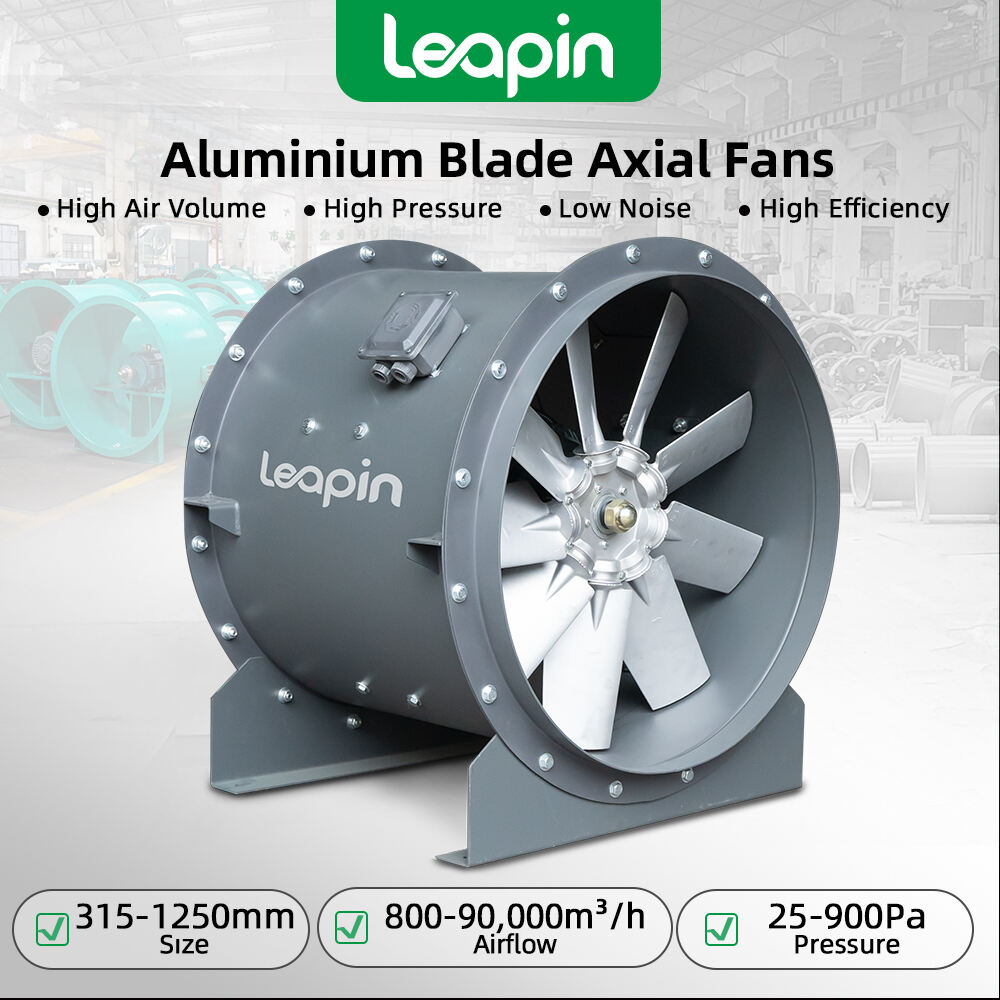Axial Fans: A Comprehensive Guide to Their Function and Applications
Understanding Axial Fans: Design and Working Principles
Core Components of Axial Flow Systems
Understanding the core components of axial fans can enhance comprehension of their functionality and application in industrial settings. Axial fans consist of several key components: blades, a hub, and a motor. The blades are pivotal as they dictate the direction of airflow and help in creating pressure necessary for effective air movement. These blades can vary in number and pitch angle, which influences the volume of air displaced. The hub acts as the central point where all blades converge, stabilizing and supporting the blade assembly. The motor, which can be an AC or DC type, drives the axle to which the blades are attached, influencing the fan's overall performance and efficiency levels. AC motors are generally preferred for providing consistent speed and longevity, while DC motors offer better energy efficiency and control.
Axial fans differentiate themselves from centrifugal fans in structure and operation. Unlike centrifugal fans, where airflow is perpendicular to the fan blade rotation, in axial fans, the airflow aligns parallel to the rotational axis—hence the name "axial." This design feature allows axial fans to move larger volumes of air at lower pressures, making them ideal for ventilation applications where high airflow is needed, but pressure demands are minimal. This contrasts with centrifugal fans, which are better suited for applications requiring high-pressure air movement due to their capability to increase air velocity through rotational force. Understanding these distinctions helps in choosing the appropriate fan type for specific industrial needs.
Aerodynamics and Energy Efficiency
Aerodynamics plays a crucial role in the functionality and efficiency of axial fans. The design of the blades significantly influences airflow patterns and energy consumption. For instance, fans with optimally curved blades allow for smoother air passage and minimize turbulence, leading to improved energy efficiency. Studies have shown that even small improvements in blade design can lead to significant enhancements in overall fan performance and energy savings. By reducing aerodynamic drag, manufacturers can lower operational costs and increase the lifespan of the fan components. Properly designed axial fans can offer superior performance by maintaining efficient airflow and minimizing energy wastage.
Optimizing fan design is not just about blade configuration but also involves selecting materials and motor types that enhance performance. By choosing high-quality materials and incorporating technologies such as variable speed controls, fans can be tailored to meet specific operational needs. Such modifications not only reduce energy consumption but can also lower noise levels, making them more suitable for environments where sound pollution is a concern. Efficient axial fans contribute to reduced operational costs over time, as they require less power to achieve the same level of airflow compared to less efficient models. Transitioning to such optimized solutions is a cost-effective strategy for industries aiming to improve sustainability and efficiency.
Key Benefits of Industrial Axial Fans
High Airflow with Low Energy Consumption
Industrial axial fans are renowned for their ability to provide high airflow while maintaining low energy consumption. Compared to other fan types like centrifugal fans, axial fans excel in delivering large volumes of air (CFM) with minimal power input. This efficiency is particularly advantageous in industries such as manufacturing and warehousing, where continuous air circulation is necessary to cool machinery and maintain air quality. For instance, studies have shown that industrial axial fans can reduce energy costs by a significant margin, as they effectively balance performance with power usage.
Adjustable Blade Configurations for Versatility
One of the standout features of industrial axial fans is their adjustable blade configurations, offering customizable airflow rates to suit various needs. This adaptability ensures that axial fans can be optimized for different operational environments and conditions. Several blade configurations are available, including variable pitch and multi-blade designs, each catering to specific applications. For example, in some industrial cases, adjustable blades have enabled the axial fans to fine-tune airflow for processes, thereby optimizing performance. Such versatility makes axial fans a preferred choice across diverse operational settings, allowing for precise control over ventilation and cooling tasks.
Axial Fan Applications in Modern Industries
HVAC Systems and Building Ventilation
Axial fans play a pivotal role in HVAC systems, providing efficient air movement and ventilation in buildings. Their ability to enhance air quality and comfort in commercial environments is unmatched. Axial fans effectively circulate air, ensuring that spaces maintain optimal temperature and freshness. A notable benefit is their remarkable efficiency; statistics reveal significant improvements in ventilation when they are integrated, leading to lower energy consumption and improved air quality. For instance, many commercial buildings successfully implement axial fans to optimize heating and cooling systems, achieving best practices in air distribution.
Industrial Exhaust and Smoke Extraction
In industrial settings, effective exhaust systems are crucial to maintaining a safe environment, especially when smoke and hazardous fumes are present. Axial fans are essential components in these systems, specifically designed to facilitate smoke extraction during emergencies. Their robust design allows them to quickly evacuate smoke and other harmful gases, ensuring compliance with stringent regulatory standards for smoke extraction. Case studies from industries highlight the successful deployment of axial fans in smoke control scenarios, showcasing their reliability and efficiency. Regulatory bodies often specify axial fans for smoke extraction due to their performance in emergency situations.
Selecting the Right Axial Fan for Your Needs
Critical Factors: CFM vs Static Pressure
When choosing an axial fan, understanding the importance of CFM (Cubic Feet per Minute) and static pressure is crucial. CFM measures the airflow volume the fan generates, essential for applications requiring specific air movement. Static pressure, on the other hand, represents the resistance the air faces when moving through components like ducts or filters. Balancing these factors is vital for optimal fan performance, especially in environments requiring specific ventilation levels. For instance, an incorrect balance can lead to inefficient operation or failure to meet airflow requirements. Consider practical examples such as the selection criteria for HVAC systems, where both CFM and static pressure play a role in maintaining desired indoor air quality.
Noise Levels and Maintenance Considerations
Evaluating acceptable noise levels for industrial axial fans is key to ensuring comfort and compliance with workplace standards. The design of axial fans greatly influences noise generation; for example, fans with specially angled blades can operate more quietly. Regular maintenance not only prolongs the fan's life but also facilitates quieter operations. Practices such as cleaning fan blades and inspecting components for wear significantly contribute to reduced noise levels and improved performance. Numerous studies underline the correlation between fan design improvements and lower noise emissions, illustrating how newer models incorporate noise reduction as a critical feature.
Top-Performing Axial Fan Solutions
ABF Series: High-Efficiency Aluminum Blade Design
The ABF Series showcases a cutting-edge design that promises high efficiency through its aluminum blade construction. A standout feature of these fans is their advanced airfoil profile, which enhances kinetic energy conversion, delivering exceptional performance in industrial environments. Compared to traditional blade designs, these fans exhibit superior airflow capabilities and energy efficiency. Customer testimonials often highlight the ease of maintenance and reliability, contributed by the corrosion-resistant cast aluminum and robust construction. Additionally, the sustainable nature of aluminum ensures environmental benefits in manufacturing processes, making the ABF Series an eco-conscious choice in industrial inline fan applications.
HTF-T Series: Fire-Rated Smoke Extraction Systems
The HTF-T Series excels in fire safety applications, offering reliable smoke extraction functionality. These fans are engineered to comply with strict fire safety regulations, making them indispensable in tunnels and underground facilities. The design incorporates advanced technology that optimizes airflow resistance, enhancing efficiency while maintaining low noise levels. Certifications from fire safety authorities underscore the HTF-T's performance capabilities, ensuring peace of mind in critical scenarios. Advancements in airflow direction control further improve the fan's adaptability to varying conditions within a facility, showcasing its suitability for demanding industrial environments that require robust smoke extraction solutions.
Aluminium Blade ABF: Corrosion-Resistant Performance
Another exceptional product is the Aluminium Blade ABF, designed with corrosion-resistant attributes that enhance durability. These fans are particularly advantageous in environments prone to corrosive elements, such as industrial plants and coastal areas. The robust construction using high-quality aluminum ensures longevity and stable performance under harsh conditions. Research indicates that ABF fans outperform other materials due to their resistance to environmental stressors, resulting in a longer lifespan and reduced maintenance costs. Users frequently share feedback highlighting the fan's reliability and efficiency, making it a trusted choice among industrial exhaust fans for challenging applications.

 EN
EN
 AR
AR
 FR
FR
 RU
RU
 ES
ES
 TL
TL
 ID
ID
 VI
VI
 TH
TH
 MS
MS
 BN
BN




